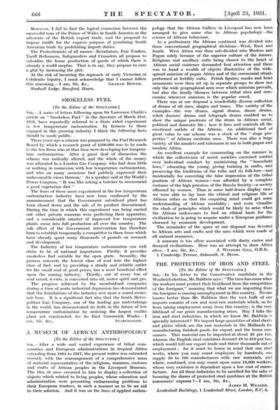A MUSEUM OF AFRICAN ANTHROPOLOGY
[To the Editor of the SPECTATOR.]
Sin,—After a wide and varied experience of tribal com- munities and European administrations in tropical Africa extending from 1884 to 1917, the present writer was entrusted recently with the rearrangement of a comprehensive mass of material representative of the religions, manners, customs and crafts of African peoples in the Liverpool Museum. The idea at once occurred to him to display a collection of objects which related to living peoples, whose education and administration were presenting embarrassing problems to their European trustees, in such a manner as to be an aid to their solution. And it was on the lines of applied anthro- pology that the African Gallery in Liverpool has now been arranged to give some clue to African psychology—the science of African behaviour.
As a preliminary the African continent was divided into three conventional geographical divisions—West, East and South. West Africa was then sub-divided into Moslem and Pagan solely because of the superior culture of the former. Religious and ancillary cults being closest to the heart of African social existence demanded first attention and there was to hand a wealth of objects illustrative of the wide- spread animism of pagan Africa and of the ceremonial rituals performed at fertility cults. Fetish figures, masks and head ornaments were then set up in separate groups to show not only the wide geographical area over which animism prevails, but also the family likeness between tribal rites and cere- monies wherever animism is the popular creed.
There was at our disposal a wonderfully diverse collection of drums of all sizes, shapes and tones. The variety of the examples—the war drums, signal drums, dance drums, witch doctors' drums and telegraph drums enabled us to show the unique positions of the drum in African social, political and domestic life ; how it fires and controls all the emotional outlets of the African. An additional find of great value to our scheme was a stock of the " stage pro- perties " of. African medicine men., There was also a large variety of the amulets and talismans in use in both pagan and moslem Africa.
An excellent example for commenting on the manner in which the collectivism of secret societies exercised control over individual conduct by maintaining the " household laws," educating the young, giving training in crafts, and preserving the traditions of the tribe and its folk-lore—and incidentally for correcting the false impression of the tribal position of African women—was afforded by a complete costume of the high priestess of the Bundu Society—a society officered by women. Thus in some half-dozen display eases we were able to lay bare the ethical and religious life of African tribes so that the enquiring mind could get some understanding of African mentality ; and even visualize the clash of principles which would be likely to arise when the African endeavours to find an ethical basis for the civilization he is going to acquire under a European guidance obsessed by economic development.
The remainder of the space at our disposal was devoted to African arts and crafts and the uses which were made of all natural resources.
A museum is too often associated with dusty curios and decayed civilizations. Here was an attempt to show Africa
alive.—I am, Sir, &c., J. WITHERS GILL, O.B.E. 1 Cambridge Terrace, Sidmouth, S. Devon.






































 Previous page
Previous page